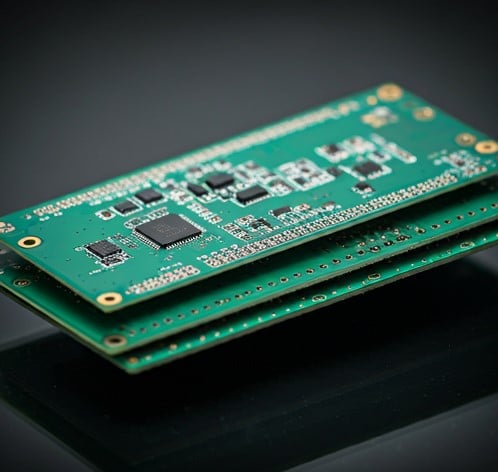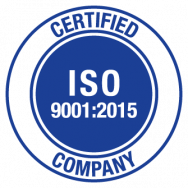PCB Materials
While the landscape of modern electronics is ever-evolving, the PCB substrate plays a rather silent but indispensable role as a crucial hero. This is because at the heart of every electronic device, whether simple or sophisticated, is a PCB or printed circuit board, with the critical PCB substrate forming its unassuming core. This virtually unknown component, crafted of specialized materials, is the very foundation determining the overall performance, efficiency, and reliability of electronic devices.
As PCB manufacturers, we, at Rush PCB Inc., will discuss PCB substrates, especially on their types, manufacturing processes, key characteristics, and the impact they have on electronics as a technology. Incidentally, we use many types of materials like:
- FR-4 Tg 140 degree
- FR-4 High Tg 160 degree
- FR-4 High Tg 180 degree
- Modified Epoxies
- Polyimide
- Cyanate Ester (Low dk/Low Loss)
- PTFE or equivalents
- Alternative HDI Dielectrics
- Halogen Free Material
- Rogers 4350
- Getek
- Nelco 6000
- BT
- Taconic
- Roger 4K Series
- Roger 3010
- Risholite
- GIL
PCB Substrates and Applications
FR-4
FR-4 is the most widely used and common substrate. The letters are an acronym standing for Fire Retardant grade 4. Being a glass-reinforced epoxy laminate, it serves as the workhorse for all types of general-purpose PCBs. Offering a good balance of mechanical strength, electrical insulation, and cost-effectiveness, FR-4 is an ideal choice for wide-ranging applications in electronics. Its properties of resistance to solvents and chemicals and low moisture absorption further enhance its durability. FR-4 is suitable for consumer electronics, automotive systems, industrial equipment, and more. Moreover, it is available for regular and high-temperature applications.
MCPCBs for Superior Thermal Management
With electronic devices becoming more compact and powerful, effective thermal management is becoming a paramount feature. To address this challenge, we have introduced MCPCBs or metal core PCBs. These boards incorporate a metal core of either aluminum or copper for enhanced heat dissipation.
The metal core in these PCBs effectively channels heat away from power-generating components, thereby ensuring optimal performance while preventing heat-induced failures. Applications of MCPCBs are in high-power LED lighting, power converters, automotive headlights, and other heat-intensive electronic devices.
Flex PCBs for Flexible Electronics
In an era of rapidly diminishing form factors, there is a surge in the demand for lightweight and flexible electronic devices. Our flexible PCBs, made from flexible materials like Polyimide and others, are the key enablers for these innovations. You can easily bend, twist, and fold our flex PCBs without compromising their functionality. This makes them the ideal choice for wearable devices, medical appliances, and aerospace applications where weight and size reduction are paramount.
High-Frequency PCBs for Wireless Communications
With wireless connectivity and high-speed data transmission in ever-increasing demand, the requirement for high-frequency PCBs has become crucial as indispensable components in communication and radar systems. We build these substrates utilizing materials that have low dielectric loss, like ceramic-filled hydrocarbons and PTFE. These materials help in maintaining signal integrity and in minimizing EMI or electromagnetic interference. Our high-frequency PCBs are very useful in satellite communication equipment, 5G wireless infrastructure, microwave devices, and radar systems.
Ceramic PCBs for Reliability and Performance
For applications demanding exceptional reliability and performance, our ceramic PCBs have proven their worth. As we make them from materials like aluminum nitrite and alumina, our substrates offer very high thermal conductivity along with excellent electrical insulation, and low dielectric loss.
Our ceramic PCBs are popularly used in power electronics, RF/Microwave devices, high-power LED applications, and other high-performance electronic systems.
Key Properties of PCB Substrate Materials
Dielectric Constant
Dk or dielectric constant is a critical property of a PCB substrate material. It determines how much degradation an electrical signal suffers as it propagates through the material. A substance with a low Dk allows high-speed signals to propagate with minimal distortion and reflection. Materials with high Dk is important for applications that require impedance matching, such as in RF/Microwave applications.
Dissipation Factor
Df or dissipation factor is another essential property of PCB substrate material. It determines how much loss of energy an electrical signal suffers as it propagates through the material. A lower Df value indicates the signal will suffer low losses, thereby exhibiting better signal integrity. Therefore, materials with lower Df values are necessary for transmitted signals to maintain their shape and quality over distance.
Thermal Conductivity
Electronic devices, especially those in high-power applications, dissipate heat. This heat must be removed effectively, as a heat build-up can be disastrous. For a PCB substrate, its thermal conductivity expresses its ability to transfer heat. A substrate with a high thermal conductivity can effectively transfer heat away from a hot component, thereby protecting more sensitive electronic components. This not only prevents heat-induced failures but also helps in maintaining the board’s optimal performance.
Coefficient of Thermal Expansion
A temperature change typically expands or contracts a material. How much it will contract or expand is defined by its CTE or coefficient of thermal expansion. PCB substrates expanding or contracting more than the components mounted on it can result in mechanical failure due to thermal stresses. To prevent such failures, we prefer to use material with CTE matching that of the components on the board. This helps to prevent failures during environmental changes or thermal cycling.

Impact of Substrates on PCB Performance
Signal Integrity — Better High-Speed Performance
The choice of substrate material significantly affects the signal integrity or the performance of high-speed signals. By using substrates of low dielectric loss and low dielectric constant, we help minimize signal reflections, absorptions, and distortions, thereby ensuring high-speed signals reach their destination with minimal degradation. We further enhance signal integrity by using proper impedance control on high-frequency PCBs.
Thermal Management — Higher Reliability
For reliable operation of electronic devices, it is essential to effectively manage the thermal aspects, especially for boards with high component densities. Our PCB substrates with their high thermal conductivities can dissipate heat effectively, preventing potential damage from overheating. In addition, we always use substrates with CTE values matching those of mounted components, thereby minimizing thermal stress and improving the overall lifespan and reliability of the device.
Flexibility — Miniaturization
Our flexible PCB substrates help to open up newer possibilities for flexible devices and miniaturization in electronic devices. For instance, you can easily bend, twist, or even fold our flex PCBs without compromising their performance. Our flexible substrates enable our customers to develop innovative, space-saving designs. Various consumer electronics, medical devices, and wearable technology applications use our PCBs with flexible substrates.
High-Frequency Operation — Communications
Modern communication systems are continuously moving towards higher frequencies. Our high-frequency substrates are keeping in step with these applications in terms of frequencies. For instance, modern communication systems are using wireless technologies like 5G. Here, low latency and high data rates are critical, and therefore, we use substrates with high thermal conductivity, low dielectric loss, and low dielectric constant. This helps our customers to minimize signal losses while maintaining signal integrity.
Internet of Things — Industry 4 Applications
The proliferation of Industry 4, IoT, or the Internet of Things has brought us to an interconnected world. Our PCB substrates are vital in supporting this growth. As IoT devices typically require small but highly energy-efficient PCBs, we are effective in driving the development of these boards with new substrate materials. We are also using newer manufacturing techniques to meet these exclusive demands.
Semiconductor Packaging — Higher Densities
With the advancement of semiconductor technologies, there is an increase in the demand for PCB substrates with finer features and higher densities. Our substrates with improved electrical performance and tighter dimensional tolerances are helping advanced semiconductor packaging techniques like wafer-level and flip-chip packaging.
Future Trends and Innovations
Rush PCB Inc. is also working towards providing our customers with newer types of PCB substrate materials.
Advanced Substrate Materials
We are exploring materials with even lower dielectric constants, lower dielectric loss, improved mechanical strength, and higher thermal conductivity.
Emerging Technologies
We are constantly providing PCBs with newer materials that support emerging technologies like the Internet of Things. Our PCB substrates offer the smart functionality and seamless connectivity that these compact and energy-efficient devices require. Our PCBs are already capable of meeting the stringent requirements of high-frequency and high-speed signals that modern 5G networks demand.
Nanotechnology
We are exploring the use of nanotechnology to improve the mechanical strength, thermal conductivity, and electrical performance of our substrates. We are confident of providing substrates that will eventually lead to even smaller but more powerful electronic devices.
Eco-Friendly Substrates
As awareness of environmental concerns grows, the demand for eco-friendly substrates is also increasing. We are exploring the development of substrates from biodegradable and renewable materials, thereby helping to reduce the impact on the environment from electronic waste.
3D Printing
We are also into additive manufacturing techniques for PCB substrates. We are already using 3D printing for manufacturing intricate designs and tailoring customized substrates for specific requirements of electronic devices.


FAQs
What is the base material most commonly used for PCBs?
FR4
What is Composite Epoxy Material?
CEM or composite epoxy material is made by combining two or more materials that have different physical and chemical properties. This helps to build substrate materials with unique characteristics and properties. The Epoxy synthetic resin acts as a binding agent for combining and holding the materials.
Where are aluminum-based boards used?
These are MCPCBs or metal core PCBs. The aluminum acts as a core to remove heat from hot components on the board and dissipate it. You use aluminum-based boards for high-power LED lights, and for applications that use high-power components on board.
How are PCBs made flexible?
While most PCBs are rigid, they typically use FR4 as the substrate. FR4 is glass fiber with epoxy as the binder, which makes it rigid. Flexible boards use Polyimide as the substrate, and as it is inherently flexible, the final board also retains that flexibility. Other properties of Polyimide are comparable to or better than those of FR4.
What are Polyester PCBs?
Polyester PCBs are made from PET or Polyethylene Terephthalate and are flexible boards. They have high moisture and chemical resistance, good flexibility, and good electrical properties. However, they have a low glass transition temperature of 80 °C, which inhibits their use in assemblies that require soldering.

